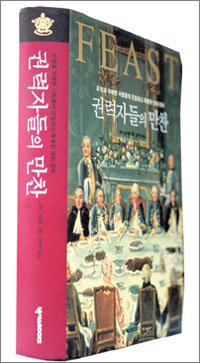Dining Tables Tell of Power

Ancient Rome and Greece-
Those who do not dine with me are barbarians.
This scribble was engraved in a Pompey mural. In the ancient Rome and Greece era, attending a banquet was one of many marks indicating civilization.
The Symposium, which was a Greek public banquet, was an alcoholic party exclusively for men, and also served as an orgy for enjoying homoeroticism. Here, the seated position was a criteria determining pecking order. Elders leaned aslant on couches, while youths drank positioned erectly.
Romans were aristocrats. The emperor invited people of diverse social strata to the feast, but discriminated in the quality of food according to rank.
The role of slaves in banquets was essential. A slave with a neat appearance diced the meals into bite-sized morsels.
Middle Ages-
Christian friars meals were extravagant, to say the least. Communal meals in seemingly abstinent convent or monastery dining halls were typical feasts in dark times. For example, the flesh of four-footed creatures was forbidden, but chefs created lavish seafood dishes instead.
In the 10th and 11th centuries, consuming substantial amounts of meat was considered to be the symbol of nobility. Landlords enacted an abstinence law and even prohibited farmers from eating meat from wild animals.
Due to the influence of Christianity, fasting became a new monastic trend, as greed became blasphemous. The dining tables of French royalty advocated asceticism, but held fast to extravagance.
The emergence of entremets is one of the representative traits of the late Middle Ages. Entremets originally meant the snacks given between meals and dessert, but was changed over the years to magnificent dishes, such as wild meat.
The Renaissance and Monarchy-
During the Renaissance, the definition of dining table had already begun to change. Platinas book, Regarding Righteous Pleasures, is an epitome. In the medieval times, the word pleasure smacked of blasphemy, but Platina insisted that gastronomy could be pious and sacred if enjoyed in the proper environment. He rationalized overeating and overdrinking.
From this time, fruits, flowers, sparkling utensils, and luscious plates overfilled the dining table, and meals that realized every possible sensual pleasure emerged. Flaunting luxury at banquets became the new norm for power and position in the new monarchy, and also became a tool for praising rulers.
After the French Revolution-
The French Revolution redefined human behavior and desire, including eating habits. With the era of freedom, equality, and philanthropy, the exclusivity of fine meals and rituals became remnants of the past.
After the revolution, the notion of food discrimination according to rank dissolved. This is clearly shown in a new style of dining hall, the restaurant. If the elite could only consume splendid food before, now anyone could eat anything they wanted, with enough money.
However, in the present media era, stars on stage and on screen, pop stars, fashion designers, and soccer players, among others, are receiving special treatment with dining tables reminiscent of ancient courts.
The dining table of courts, castles of royalty, and Bourgeoisie mansions have moved to sophisticated restaurants, but the dining table still exudes its power in dictating social yearning and privilege awareness.
The original title of the book is Feast,(2002).
klimt@donga.com







